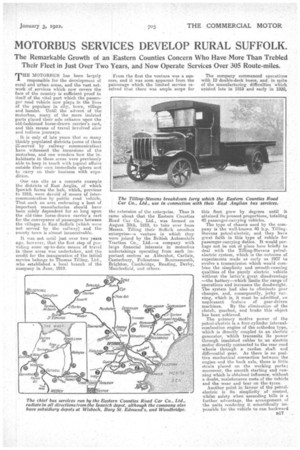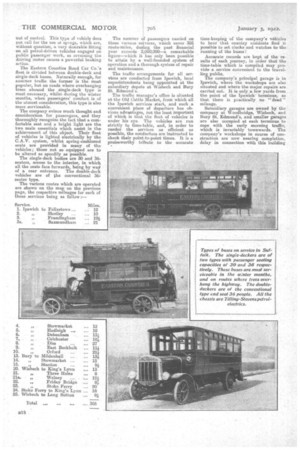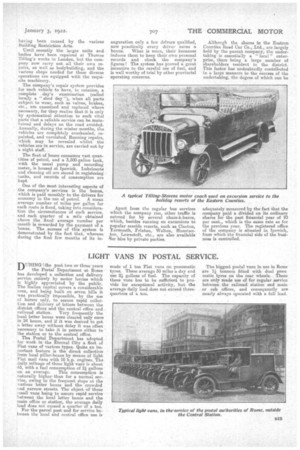MOTORBUS SERVICES DEVELOP RURAL SUFFOLK.
Page 17

Page 18

Page 19

If you've noticed an error in this article please click here to report it so we can fix it.
The Remarkable Growth of an Eastern Counties Concern Who Have More Than Trebled Their Fleet in Just Over Two Years, and Now Operate Services Over 305 Route-miles.
THE MOTORBUS has been largely responsible for the development of rural and urban areas, and the vast network of services which now covers the face of the country is sufficient proof in itself of the vital part which the pasaenger road vehicle now plays in the lives of the populace in city, town, village and hamlet. Until the adventof the motorbus, many of the more isolated parts placed their sole reliance upon the old-fashioned horse-drawn carrier's cart, and this means of travel involved slow and tedious journeys, it is only of late years that so many thickly populated districts (some of them ill-served by railway communication) have witnessed the incursions of the motorbus, and one wonders how the inhabitants in these areas were previously able to keep in touch with topical affairs outside their own immediate sphere and to carry on their business with expedition.
One can cite as a concrete example the districts of East Anglia, of which IpSwich forms the hub, which, previous to 1919, were devoid of means of intercommunication by public road vehicle. That .auch an area embracing a host of important manufactories should have been solely dependent for so long upon the old-time horse-drawn carrier's cart for the conveyance of passengers between the villages in East Suffolk (which were not served by the railway) and the county. town is almost inconceivable.
It was not until just over two years ago, however, that; the first step of providing. some up-to-date means of travel in these areas was undertaken, and the credit for the inauguration of the initial service belongs to Thomas Tilling, Ltd., who established a local branch of the company in June, 1919.
From the first the venture was a success, and it was soon apparent from the patronage which the limited service received that there was ample scope for the extension of the enterprise. Thus it came about that the Eastern Counties Road Car Co., Ltd., was formed on August 30th, 1919, to take over from Messrs. Tilling their Suffolk omnibus enterprise—a venture in which they were joined by the British Automobile Traction Co., Ltd.—a company with largo financial interests in motorbus undertakings operating from such important centres as Aldershot, Carlisle, Canterbury, Folkestone Bournemouth, Brighton, Cambridge, Reading, Derby, Macclesfield, and others.
• The company commenced operations with 12 double-deck buses, and, in spite of the manufacturing difficulties which existed late in 1919 and early in 1920,
this fleet grew by degrees . until it attained its present proportions, totalling 40 passenger-carrying vehicles.
The type of chassis used by the company is the well-known 40 le.p. TillingStevens petrol-electric, and they have great faith in this type of vehicle for passenger-carrying duties. It would perhaps not be out of place here briefly to deal with the Tilling-Stevens petrolelectric system, which is the outcome of experiments made as early as 1907 to evolve a transmission which would combine the simplicity and smooth-running qualities of the purely electric vehicle without the latter's great disadvantage —the battery—which-limits the range of operations and increases the deadweight. The system had also tu eliminate gear changes, and, consequently, jerky running, which is it must be admitted, an unpleasant feature of gear-driven
machines. By the elimination .of the clutch, gearbox, and brake this object has been achieved.
The primary motive power of the petrol-electric is a four-cylinder internalcombustion engine of the orthodox type, which is directly coupled to an electric generator, which transmits its power through insulated cables to an electric motor directly connected to the rear road wheels through a cardan shaft and differential gear. As there is no positive mechanical connection between the engine and the back axle, there is little strain placed an the working parts; moreover, the smooth starting and running -which is obtained influence, without a doubt, maintenance costs of the vehicle and the wear and tear on the tyres.
Another point in favour of thp petrolelectric is its simplicity of control, whilst safety when ascending hills is a further advantage, the arrangement of the units rendering it scientifically impossible for the vehicle to run backward
J3
out of control. This type of vehicle does got call for the use as sprags, which are, without question, a very desirable fitting on all petrol-driven vehicles engaged on public passenger work, as reversing the driving motor causes a powerful braking action.
The Eastern Counties Road Car Co.'s fleet is divided between double-deck and siegle-deck buses. Naturally enough, for summer traffic the former is the most popular, but on roads where overhanging trees abound the single-deck type is most necessary, whilst during the winter months, when passengers' comfort is of the utmost consideration, this type is also more serviceable.
The company evince much thought and consideration for passengers, and they thoroughly recognize the fact that a camfortable seat and a bright light are the two main essentials which assist in the achievement of this object. Their fleet of vehicles is lighted electrically by the C.A.V. system, whilst spring-cushioned seats are provided in many of the vehicles; those not so equipped are to be altered as speedily as possible. The single-deck bodies are 30 and 36seaters, access to the interior, in which all the seats face forwards, being by way of a rear entrance. The double-deck vehicles are of the conventional 364 seater type.
The various routes which are operated are shown on the map on the previous page, the respective mileages for each of these services being as follow;— The number of passengers carried on these various services, which cover 305 route-miles, during the past financial year exceeds 2,000,000—a remarkable figure—which it has only been possible to attain by a well-founded system of operation and a thorough system of repair and maintenance.
The traffic arrangements for all services are conducted from Ipswich, local superintendents being appointed at the subsidiary depots at Wisbech and Bury St. Edmund's.
The traffic manager's office is situated at the Old Cattle Market, from which all the Ipswich services start, and such a convenient place of departure has obvious advantages, not the least important of which is that the fleet of vehicles is under his •eye. The vehicles are run strictly to time-table, and, in order to render the services as efficient as possible, the conductors are instructed to check their point-to-point times. It is a praiseworthy tribute to the •accurate
time-keeping of the company's vehicles to hear that country residents find it possible to set clocks. and watches to the running of the buses !
Accurate records are kept of the results of each journey, in order that the time-table which is compiled may provide a service convenient to the travelling public. The company's principal garage is in Ipswich, where the workshops are also situated and where the major repairs are carried out, It is only a few yards from the point of the Ipswich terminus, so that there is practically no "dead mileage.
Subsidiary garages are owned by the company at Woodbridge, Wisbech, and Bury St. Edmund's, and smaller garages are also occupied at each terminus to cope with the early morning traffic, which is invariably townwards. The company's workshops in course of construction are now nearing completion, delay in connection with this building having been caused by the various Building Restriction Acts.
Until recently the larger units and bodies have been repaired at Thomas Tilling's works in London, but the company now carry out all their own repairs, as well as bodybuilding, and the various shops needed for these diverse operations are equipped with the requisite machinery.
The company's repair system provides for each vehicle to have, in rotation, a complete day's examination (called locally a "shed day "), when all parts subject to wear, such as valves, brakes, etc., are examined and replaced where necessary, for they realize that it is only by systematical attention to such vital parts that a reliable service can be maintained and delays on the road avoided. Annually, during the winter months, the vehicles are completely overhauled, repainted, and varnished. Running repairs, which may be revealed whilst the vehicles are in service, are carried -out by a night staff.
The fleet of buses consumes vast quantities of petrol, and a 3,500-gallon tank, with the usual pump and recording meter, is housed at Ipswich. Lubricants and cleaning oil are stored in registering tanks, and records of consumption are kept.
One of the most interesting aspects of the company's services is the bonne, which is paid monthly to the drivers for economy in the use of petrol. A mean average number of miles per gallon for each route is fixed, taking into consideration the circumstances of each service, and each quarter of a mile obtained above the fixed average number per month is rewarded by the payment of a bonus. The success of this syStem is demonstrated by the fact that, whereas. during the first few months of its in.
auguration only a few drivers qualified, now practically every driver earns a bonus. What is more, their keenness induces them to keep their own personal records and check the company's figures! The system has proved a great incentive to the careful use of fuel, and is well worthy of trial by other provincial operating concerns.
Apart from the regular bus services which the company run, other traffic is catered for by several chars-a-bancs, which, besides running on excursions to popular seaside resorts, such as Clacton, Yarmouth, Frinton, Walton, Hunstanton Lowestoft, etc., are also available or hire by private parties. Although the shares in the Eastern Counties Road Car Co., Ltd., are largely held by the parent company, the undertaking is essentially a " local " enterprise, there being a large number of shareholders resident in the district. This factor has undoubtedly contributed in a large measure to the success of the undertaking, the degree of which can be adequately measured by the fact that the company paid a divided on its ordinary shares for the past financial year of 10 per cent., which is the same rate as for the previous year. The registered office of the company is situated in Ipswich, from which the financial side of the business is controlled.




























